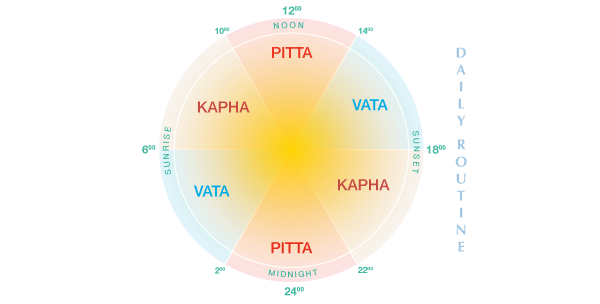Let’s face it: our mental health has suffered greatly over the past year 2020. Especially anxiety disorders, but also depressions have increased, because many familiar structures have fallen away and compensating social contacts have been reduced to a minimum.
So it’s easy to understand why Vata disorders have been a frequent cause for treatment in our Ayurvedic practice in recent months.
In many patients, the anxiety cannot be identified directly, but shows itself through physical symptoms, such as abdominal pain, sleep disturbances, sweating, or exhaustion.
What exactly is Vata imbalance?
Vata is a Sanskrit term that can be analyzed as “Va” for drive, thrust, plus “Ta” for energy. Vata signifies the effect of the two elements air and ether. Also in traditional Chinese medicine or Tibetan medicine, so-called wind diseases are well-known. In Ayurveda we call them Vata disorders.
Accordingly, Vata is a dynamic force that, when increased, can express itself on a physical and mental level. This is related to the ether element in particular, which is subtle, unlimited and invisible, and has a direct connection with our conscious and subconscious psyche. Ninety percent of all psychosomatic diseases are caused by an imbalance in Vata Dosha.

From the point of view of conventional medicine, this may be difficult to understand at first, since Vata itself cannot be measured. However, the same is true for stress, because only manifesting symptoms can be measured, such as heart palpitations or accelerated breathing. Stress itself has no direct indicator of its own, even though some specific blood levels allow conclusions to be drawn about elevated stress.
Ayurvedic diagnostics has the advantage of being able to quickly detect excess Vata by means of pulse diagnosis. In combination with the described complaints, this usually gives a very clear picture.
So when Vata gets out of balance, the excessive drive can cause so-called Citta Vritti, literally a monkey mind, i.e. a mind that keeps jumping from one thing to another and doesn’t let one settle down.
Causes for Vata disorders
The search for root causes is based on the most important triggers for Vata disorders, associated with modern life in the so-called civilized countries. They can be summed up in a simple expression: too much, too fast, too often. Examples:
- sleeping too late
- getting up without a good night’s sleep
- irregular daily rhythm
- irregular meal times
- no sufficient rest periods at night and also during the day
- restlessness due to television: fast-changing images, stressful content (thrillers, news, etc.), especially before going to bed
- pressure from work and schedules
- familial and professional worries
- lack of emotional support due to broken personal relationships.
When the body, influenced by many of these factors, is in an accelerated state over a long period of time, it automatically learns to adapt to a new – overly fast – level of functioning. Regeneration processes no longer get the chance to do their necessary work, at least not to a sufficient degree.
In this case, the sympathetic nervous system – the part of our nervous system that puts the body into heightened performance mode – is activated permanently, keeping the body trapped in a persistent fight-or-flight mode.
Sleep disorders are often accompanied by anxiety and depression
People with Vata disorders often experience sleep disorders as a burdening companion. And this is not by chance: While during the Pitta time around noon (10 a.m. – 2 p.m.) the assimilation of food reaches its peak and the food broken down in the gastrointestinal tract is absorbed into the blood, the metabolism also works at full speed during the Pitta time around midnight. Unnoticed by the sleeper, the body now transports the already minutely digested molecules from the blood into the body cells.

In people who do not sleep deeply between 10 p.m. and 2 a.m., this mechanism is impaired, whether this is due to sleep problems or a shifted day-night rhythm. If deep sleep is lacking in the Pitta period or if it is permanently shortened, fewer nourishing substances reach the body cells and thus also the nerve cells. These insufficiently supplied nerve cells are less resilient during the day, and the vicious circle deepens.
Ayurveda is the art of balancing disturbances by their opposite
The tormented body-mind structure needs to be rebalanced through rest and regularity in all its variations. Here’s some things you can do:
- Consciously get an early night’s rest.
- Wake up without an alarm clock.
- Right at sunrise, look into the sunlight for one minute.
- Take a daily sunbath, early in the morning or late in the afternoon.
- Eat at regular times, chewing well and eating in a quiet setting.
- Give preference to Vata-pacifying food and generally the tastes sweet, sour and salty.
- Take warm drinks during the day, like hot water, soothing herbal teas, Vata tea.
- Drink warm milk with freshly ground nutmeg before going to bed.
- After the noon meal, lie on your left side for 30 min.
- Give yourself an Abhyanga every morning, especially head, ears, and feet. (Abhyanga is a full-body massage with warm, cured sesame oil.)
- Take nerve-strengthening and Vata-reducing Ayurvedic herbs such as Ashwagandha, Jatamansi, Guduchi or Brahmi. Or even better, ask your Ayurvedic doctor which herbal preparations are most suitable for your individual condition and requirements.
- Take brisk walks in the fresh air (no jogging!), preferably in a quiet environment. In addition, take a walk right before going to bed.
- Practice gentle Yoga postures; do a light breathing exercise (Pranayama) several times a day for about five minutes.
- Meditate twice a day in an undisturbed setting.
Just a few weeks of such an orderly routine is almost always sufficient for a clear and lasting balancing effect.
The “failing of the intellect”
In the classical Ayurvedic texts, emotional disturbances are identified as the main cause of all imbalances of the Doshas, particularly the “failing of the intellect”, Pragyaparadh.
“The root cause of imbalance of the Doshas is living in a way that is not in accordance with the laws of nature. … This has its origin in Pragyaparadh.” Charaka, Vi, III, 20.
This perfectly describes the condition of man in our present, fast-moving times: people who so identify themselves with the external aspects of life that they can no longer perceive their actual, inner nature and thus neither perceive nor pay attention to their own needs. The direct and regular experience of the state of mental silence has the greatest healing power and quickly improves Vata disorders in particular.
This can be provided by meditation, in particular Transcendental Meditation (TM), which is a technique enabling the direct experience of the unboundedness of one’s inner self already during the first practice sessions. Within minutes, all stress hormones in the body are reduced, as well as breathing and heart rate, while skin resistance increases.
In research studies, patients with long-standing PTSD (post-traumatic stress syndrome) showed a marked reduction of symptoms such as anxiety and sleep disruption within the first few weeks of learning the technique.
And there is always the rapid yet thorough therapy, Ayurveda’s royal road: the classical Panchakarma course of treatment. It includes detoxifying and soothing oil massages, oil pours and cleansing treatments, which logically build one upon the other and establish a new equilibrium within a surprisingly short time. Away from the stressful environment at home, a complete reset is possible. Even though the symptoms may seem bad to those affected, the Ayurvedic doctor knows that they are “only” pronounced Vata disturbances – and the good news here is that “Vata (disturbance) comes quickly and goes quickly.”
The more Vata-calming measures are used simultaneously, the more swiftly the healing process advances, which is usually much faster than you could have imagined at the beginning.

© Maharishi Ayurveda Privatklinik Bad Ems